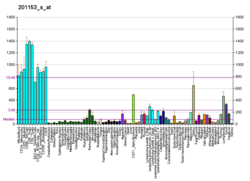Myotonia is a symptom of a small handful of certain neuromuscular disorders characterized by delayed relaxation of the skeletal muscles after voluntary contraction or electrical stimulation.
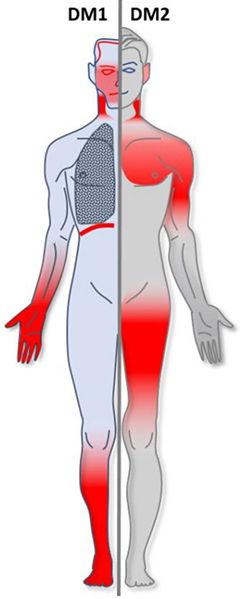
Myotonic dystrophy (DM) is a type of muscular dystrophy, a group of genetic disorders that cause progressive muscle loss and weakness. In DM, muscles are often unable to relax after contraction. Other manifestations may include cataracts, intellectual disability and heart conduction problems. In men, there may be early balding and an inability to father children. While myotonic dystrophy can occur at any age, onset is typically in the 20s and 30s.

Pre-mRNA-processing-splicing factor 8 is a protein that in humans is encoded by the PRPF8 gene.

Myotonin-protein kinase (MT-PK) also known as myotonic dystrophy protein kinase (MDPK) or dystrophia myotonica protein kinase (DMPK) is an enzyme that in humans is encoded by the DMPK gene.

X-linked retinitis pigmentosa GTPase regulator is a GTPase-binding protein that in humans is encoded by the RPGR gene. The gene is located on the X-chromosome and is commonly associated with X-linked retinitis pigmentosa (XLRP). In photoreceptor cells, RPGR is localized in the connecting cilium which connects the protein-synthesizing inner segment to the photosensitive outer segment and is involved in the modulation of cargo trafficked between the two segments.

Heterogeneous nuclear ribonucleoprotein G is a protein that in humans is encoded by the RBMX gene.

Polyadenylate-binding protein 2 (PABP-2) also known as polyadenylate-binding nuclear protein 1 (PABPN1) is a protein that in humans is encoded by the PABPN1 gene. PABN1 is a member of a larger family of poly(A)-binding proteins in the human genome.

Transcription factor SOX-4 is a protein that in humans is encoded by the SOX4 gene.

CUG triplet repeat, RNA binding protein 1, also known as CUGBP1, is a protein which in humans is encoded by the CUGBP1 gene.
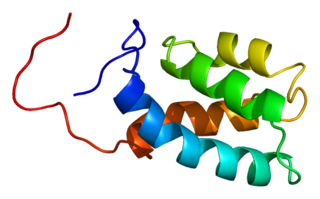
U4/U6 small nuclear ribonucleoprotein Prp3 is a protein that in humans is encoded by the PRPF3 gene.

CUGBP, Elav-like family member 2, also known as Etr-3 is a protein that in humans is encoded by the CELF2 gene.
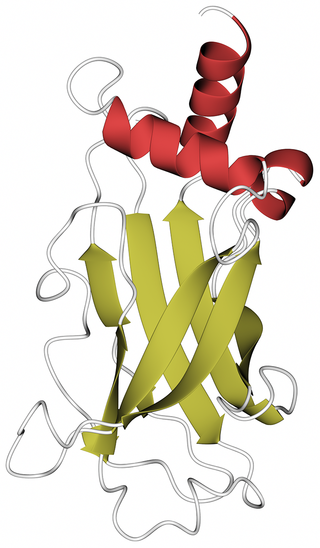
X-linked retinitis pigmentosa GTPase regulator-interacting protein 1 is a protein in the ciliary transition zone that in humans is encoded by the RPGRIP1 gene. RPGRIP1 is a multi-domain protein containing a coiled-coil domain at the N-terminus, two C2 domains and a C-terminal RPGR-interacting domain (RID). Defects in the gene result in the Leber congenital amaurosis (LCA) syndrome and in the eye disease glaucoma.

Cellular nucleic acid-binding protein is a protein that in humans is encoded by the CNBP gene.

Dystrophia myotonica WD repeat-containing protein is a protein that in humans is encoded by the DMWD gene.
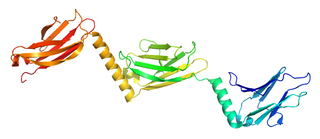
Myomesin-1 is a protein that in humans is encoded by the MYOM1 gene. Myomesin-1 is expressed in muscle cells and functions to stabilize the three-dimensional conformation of the thick filament. Embryonic forms of Myomesin-1 have been detected in dilated cardiomyopathy.
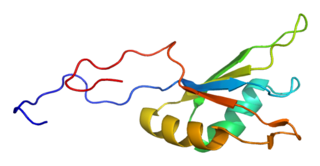
Fox-1 homolog A, also known as ataxin 2-binding protein 1 (A2BP1) or hexaribonucleotide-binding protein 1 (HRNBP1) or RNA binding protein, fox-1 homolog (Rbfox1), is a protein that in humans is encoded by the RBFOX1 gene.

Muscleblind-like protein 3 is a protein that in humans is encoded by the MBNL3 gene.
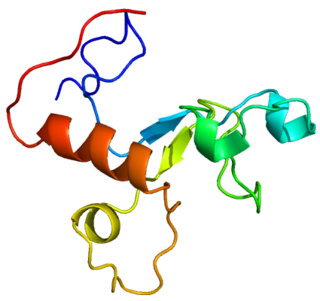
Muscleblind-like protein 2 is a protein that in humans is encoded by the MBNL2 gene.
RNA-dominant diseases are characterized by deleterious mutations that typically result in degenerative disorders affecting various neurological, cardiovascular, and muscular functions. Studies have found that they arise from repetitive non-coding RNA sequences, also known as toxic RNA, which inhibit RNA-binding proteins leading to pathogenic effects. The most studied RNA-dominant diseases include, but are not limited to, myotonic dystrophy and fragile X-associated tremor/ataxia syndrome (FXTAS).
RNA-targeting small molecules represent a class of small molecules, organic compounds with traditional drug properties that can bind to RNA secondary or tertiary structures and alter translation patterns, localization, and degradation.





